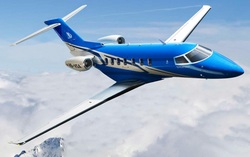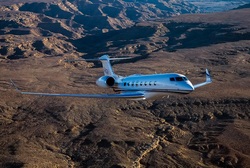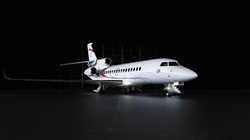|
Technicon Design in Paris, France designed a windowless aircraft, dubbed the Ixion windowless jet. “I challenged the team to break out of conventional thinking with regards to a business jet exterior and interior,” says Gareth Davies, design director at Technicon Design’s studio near Paris.
The Ixion windowless jet design concept utilizes flexible screens which cover the cabin walls and ceiling inside the aircraft. The screens display views captured from external cameras mounted around the aircraft to show the surrounding environment in real time, which can give the passengers the feeling of flying through the air in an invisible airplane. With this setup, passengers can also conduct business video conferences, and presentations, watch state-of-the-art in-flight movies, or even project relaxing landscapes to change the feel. This video demonstrates the range of possibilities you can experience within the plane, along with the high-tech amenities and features.
1 Comment
 It's official. You can now place an order with Pilatus to buy your very own PC-24 business jet — provided you can come up with the $8.9 million it will cost to do so. Pilatus confirmed at EBACE in Geneva yesterday that it is now taking orders for the twinjet, certification for which is expected in early 2017. The Swiss manufacturer plans to begin flight testing this summer at its home base in Stans. By the close of the the day today, Pilatus reported having recived orders for 75 PC-24s. Notable features of the PC-24 include a large rear cargo door similar to that of the PC-12 turboprop, as well as a beefy landing gear for operating from rough strips. The cabin will have room for six to eight passengers. Range is targeted at nearly 2,000 nm, while max cruise speed is listed at 425 knots at FL 300. By: Stephen Pope  Gulfstream launched its latest luxury bizjet offering at a press conference preceding today's opening of the European Business Aviation Convention and Exhibition (EBACE) in Geneva, Switzerland. Improving upon its highly successful G650, the Savannah, Georgia-based company launched the G650ER — ER for extended range — enabling the business jet to fly an additional 500 nautical miles. This translates to a range of 7,500 nm at Mach 0.85, giving the G650ER the longest legs of any business jet, according to Scott Neal, Gulfstream's senior vice president of worldwide sales and marketing. The extended range allows the G650ER to reach destinations that were previously not possible without a fuel stop. During flight testing the G650ER flew from Hong Kong to Teterboro, New Jersey, a distance of 7,494 nm, in 14 hours and 7 minutes, landing with NBAA IFR reserves. Neal said the airplane could fly from Geneva to Hawaii. Gulfstream has delivered more than 60 G650s since its introduction to the market in 2012. The main difference between the G650 and the G650ER is the size of the fuel tanks, allowing for an additional 4,000 pounds of jet-A for a total fuel capacity of 48,200 pounds. An increase in the gross weight has allowed the G650ER to maintain the 54,000 basic operating weight. The extended range capability requires no structural modifications and the ER option will be available as an aftermarket add-on for existing G650 customers. Pricing has not yet been released for the G650ER or the aftermarket modification. Gulfstream hopes to achieve FAA certification for the G650ER later this year, with first deliveries and the availability of upgrades in the first quarter of next year. Gulfstream said the original G650 will continue to be offered as well. By Pia Bergqvist  French luxury jet builder Dassault threw down the gauntlet at EBACE in Geneva with the launch of the Falcon 8X, a new flagship trijet that is intended to go head-to-head with the class-leading ultra-long-range Gulfstream G650 and Bombardier Global family. The 19-seat Falcon 8X is a stretched version of the Falcon 7X that will boast a range of 6,450 nm, or about 500 nm more than the 7X, making nonstop flights possible between Beijing and New York, Hong Kong and Seattle, and Paris and Singapore. Priced at $58 million, the Falcon 8X will feature a fuselage that is nearly 4 feet longer than the 7X. Power will come from three Pratt & Whitney Canada turbofans that, when combined with an improved wing design, will offer a claimed fuel efficiency improvement of 35 percent over competing ultra-long-range jets. Dassault expects certification for the Falcon 8X in mid-2016, with deliveries to begin later that year. Written by: Stephen Pope Tuesday, March 4, 2014 - 1:00pm - by Mark Phelps
A recent CNBC news item noted that Formula One racing tycoon Bernie Ecclestone “flipped” his new G650 just weeks after he took delivery. An Asian industrialist who didn’t want to wait out Gulfstream’s order backlog for the popular new model bought it for $72 million—$7.5 million more than the list price. The report quoted a blogger who wrote that “the plane was too large for some of Ecclestone’s favorite airports.” I say…propwash. People who advise the VIPs who buy business jets—you can bet Ecclestone had professional help—don’t make mistakes like that. I’m willing to bet a left-handed lug nut from one of his cars (which is about the only part of them I could afford) that it was the smell of $7.5 million that sealed the deal, not a sudden epiphany about airports the Gulfstream couldn’t use. (Keep in mind that the G650 has impressive short-runway performance numbers to go along with its jumbo cabin and Mach 0.925 cruise speed.) Television shows have highlighted real estate dabblers who turn a profit by “flipping” houses—buying rundown properties on the cheap, then sprucing them up at minimal cost and remarketing them for a substantial profit. The CNBC report implied that buyers holding contracts on new business jets are cut from the same cloth, but that’s not really accurate, especially with early adopters of developmental models such as the G650. Ordering a not-yet-certified jet isn’t as simple as signing on the dotted line for a dilapidated house. It’s a multistep process, more akin to negotiating a deal with a contractor to build a factory or office building. There’s an upfront payment, followed by a graduated series of “progressive” payments pegged to project milestones. For example, a payment of, say, 15 percent, might be due when the prototype flies for the first time or when the airplane receives its certification. The length of the order backlog offers one measure of the health of a new-airplane project. Sometimes, the first few years of production may be spoken for before the prototype even flies. But the development process could take several years, and in the interim, a lot can happen—to the new-airplane program but also to the fortunes of the contract holder—that affects the original deal. For example, demand for the jet could skyrocket, and the buyer could be bombarded with offers for “his” airplane even before it rolls out of the factory. Or maybe the buyer’s company falls on hard times and has to divest at a disadvantage. For the manufacturer, this is a double-edged sword. On the one hand, contract holders flipping their delivery positions represent a testament to the popularity of the new model. But the other side of the coin is the negative image of buyers “selling out” their interest in the new airplane. In the worst-case scenario, such buyers might have been cited in high-profile ads or other promotional campaigns. At the very least, salespeople pitching other customers may have shared in discreet conversations with their own prospects that “Mr. So-and-so is buying one” (but only with Mr. So-and-so’s approval, of course). The other downside for manufacturers is that they still view an established customer flipping a jet as a sale gone wrong. They see the original buyer as bailing out of the deal and regard the secondary buyer as a former potential order holder who is now off the list of prospects. And all the multiple secondary negotiations on finance, warranty details, maintenance arrangements and myriad other details must start from scratch. So manufacturers don’t view stories like the CNBC report as good news. As a result, business jet makers have “non-assignability” clauses in contracts to discourage customers from acting like spec buyers and selling their positions. It’s written into the deal that the original buyer must be the one who takes the keys. But that photo op sometimes disguises the reality that the secondary buyer is lurking out of sight of the cameras, itching to go for a spin in his new ride. Mark Phelps (mphelps@bjtonline) is a freelance writer and private pilot. |
JetElite AviationLET YOUR PRIORITIES TAKE FLIGHT Archives
October 2014
Categories |

 RSS Feed
RSS Feed

